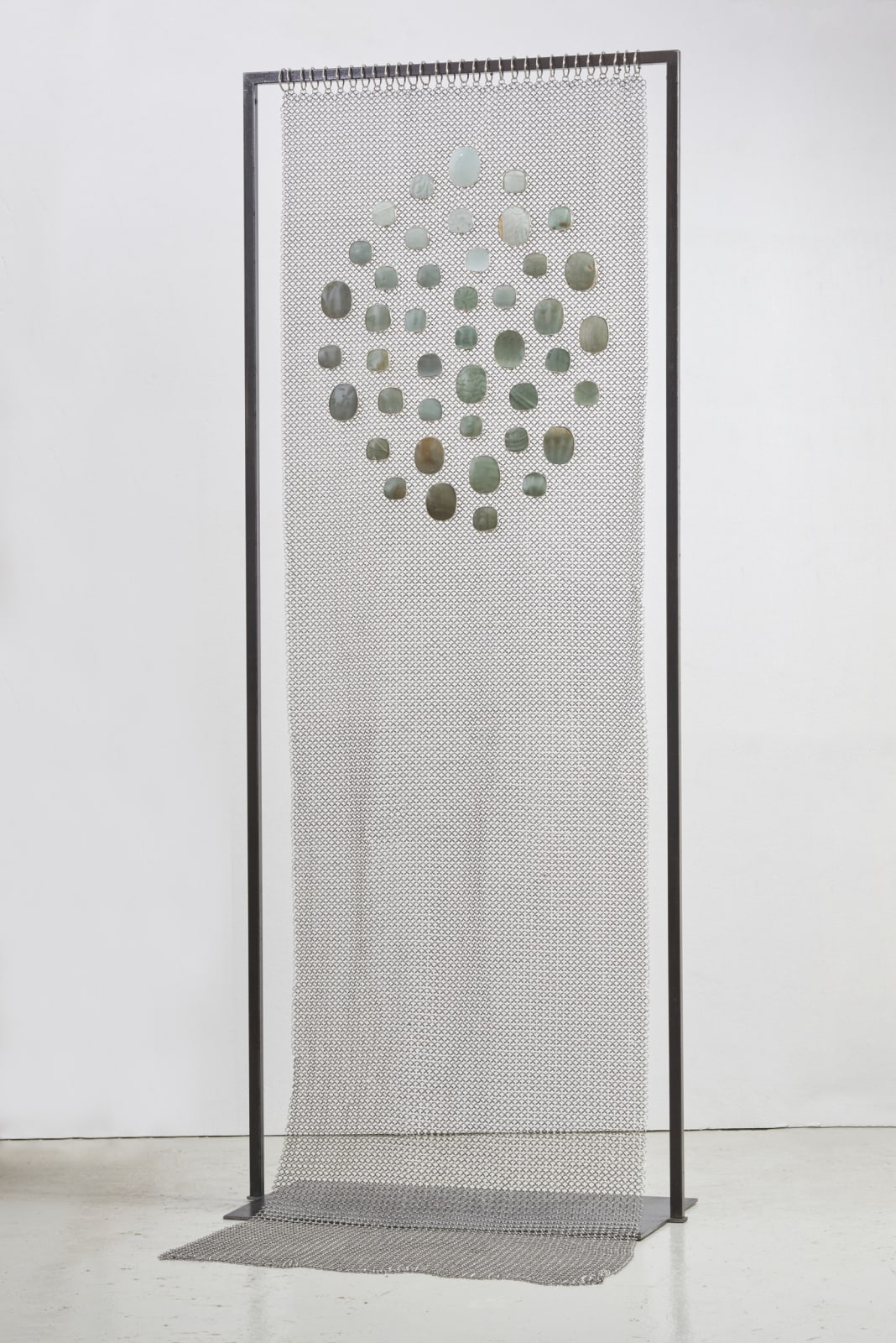Leelee Chan 陳麗同
Celadon Weaver 青瓷編織者, 2020
ceramic shards (Qingbai ware, Longquan ware and Yaozhou ware) from Song to Ming dynasties (10th to 17th centuries AD), 925 silver, stainless steel chain mail and steel stand
宋朝至明朝(公元10至17世紀)的影青瓷、龍泉瓷和耀州瓷碎片、925純銀、不銹鋼鎖子甲和鋼架
宋朝至明朝(公元10至17世紀)的影青瓷、龍泉瓷和耀州瓷碎片、925純銀、不銹鋼鎖子甲和鋼架
177 x 70 x 33 cm
69 1/2 x 27 1/2 x 13 in
69 1/2 x 27 1/2 x 13 in
Further images
Leelee Chan's work Celadon Weaver was part of a group exhibition, 'Up-Close, Hollywood Road' (2020), a collaborative project involving four antique stores on Hollywood Road in Hong Kong's Central district...
Leelee Chan's work Celadon Weaver was part of a group exhibition, "Up-Close, Hollywood Road" (2020), a collaborative project involving four antique stores on Hollywood Road in Hong Kong's Central district that aimed to spark a dialogue between history and modernity and between art and craft. Curators Hilda Chan and Iven Cheung commissioned contemporary sculptors to create contemporary relics, ones which define the present for people in the future.
Chan started with broken ceramic wares in different shades of green, more specifically Qingbai ware, Longquan ware and Yaozhou ware dating from the Song to Ming dynasties (10th to 17th centuries AD). Studying ceramic shards is not only essential to the understanding of the authenticity of ceramic wares, it is also an invaluable opportunity to learn more about and appreciate their unique craftsmanship.
Chan polished these shards into oval discs and set them in silver bezels, which were then connected to a chain mail of interlinked metal rings. Inspired by the gallery owner’s collection of textiles and furniture, including a Ming dynasty clothes rack made from huanghuali (“yellow flowering pear”) wood, the chain mail with the shards is draped over a free-standing structure, resembling a piece of fabric flowing over a clothes rack. The monochromatic glazes, humble shapes and undulating carved motifs of the ceramic shards reflect the sedate beauty that Song dynasty aesthetics and philosophy aspired to.
陈丽同的作品《青瓷编织者》在群展“走近 – 荷李活道“中展出。这是一个与香港荷李活道上的四家古董店的合作项目,旨在激发历史与现代、艺术与工艺之间的对话。策展人陈芍君和张耀辉委托当代雕塑家创造当代遗迹,为未来的人们定义现在。
陈丽同选用了深浅不一的绿色瓷器碎片,包括宋朝至明朝(公元10至17世纪)的影青瓷、龙泉瓷和耀州瓷碎片。研究瓷片不仅有助于鉴定瓷器的真伪和来历,更是深入了解和欣赏其独特工艺的珍贵契机。
艺术家将这些瓷片打磨成椭圆形,镶上银边,再将其固定在金属链环编织而成的锁子甲上。灵感来自古董店主收藏的纺织品与家具,其中包括一件明代黄花梨木衣架。艺术家将这件瓷片锁子甲披挂在一个独立支架上,仿佛一块布料从衣架垂落。瓷片上单色釉的光泽、朴素的器形以及起伏的刻划纹样,正映照出宋代美学与哲思所追求的沉静内敛之美。
Chan started with broken ceramic wares in different shades of green, more specifically Qingbai ware, Longquan ware and Yaozhou ware dating from the Song to Ming dynasties (10th to 17th centuries AD). Studying ceramic shards is not only essential to the understanding of the authenticity of ceramic wares, it is also an invaluable opportunity to learn more about and appreciate their unique craftsmanship.
Chan polished these shards into oval discs and set them in silver bezels, which were then connected to a chain mail of interlinked metal rings. Inspired by the gallery owner’s collection of textiles and furniture, including a Ming dynasty clothes rack made from huanghuali (“yellow flowering pear”) wood, the chain mail with the shards is draped over a free-standing structure, resembling a piece of fabric flowing over a clothes rack. The monochromatic glazes, humble shapes and undulating carved motifs of the ceramic shards reflect the sedate beauty that Song dynasty aesthetics and philosophy aspired to.
陈丽同的作品《青瓷编织者》在群展“走近 – 荷李活道“中展出。这是一个与香港荷李活道上的四家古董店的合作项目,旨在激发历史与现代、艺术与工艺之间的对话。策展人陈芍君和张耀辉委托当代雕塑家创造当代遗迹,为未来的人们定义现在。
陈丽同选用了深浅不一的绿色瓷器碎片,包括宋朝至明朝(公元10至17世纪)的影青瓷、龙泉瓷和耀州瓷碎片。研究瓷片不仅有助于鉴定瓷器的真伪和来历,更是深入了解和欣赏其独特工艺的珍贵契机。
艺术家将这些瓷片打磨成椭圆形,镶上银边,再将其固定在金属链环编织而成的锁子甲上。灵感来自古董店主收藏的纺织品与家具,其中包括一件明代黄花梨木衣架。艺术家将这件瓷片锁子甲披挂在一个独立支架上,仿佛一块布料从衣架垂落。瓷片上单色釉的光泽、朴素的器形以及起伏的刻划纹样,正映照出宋代美学与哲思所追求的沉静内敛之美。













